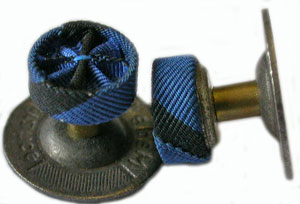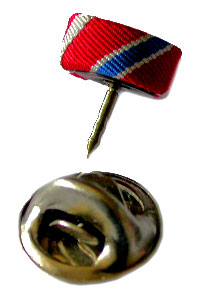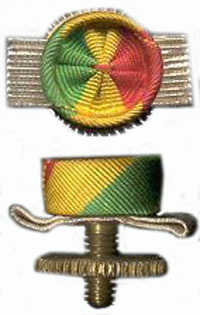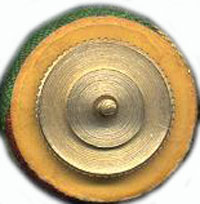
Button Hole

Clutch back


Screw Back
Around 1850, the rosette was modestly
redesigned
and miniaturized so that it could be worn on clothing in a
manner more
appropriate for civilian use.
In 1877, the Military Order of the Loyal
Legion
of the United States became the first organization in the U.S.
to use a
lapel rosette to identify its
members.
Today, lapel rosettes are awarded to, and
worn proudly by, members of various types of organizations in
both public
and private sectors. They are
presented as a symbol of achievement, or
in
recognition of an individual’s allegiance or affiliation to a
particular
organization.
1-On a Full size/ mini- Medal to
distinguish
the ranking within that Award/Class Medal
2-On a Ribbon bar to take the place of
the
Medal, [1 and 2 use a thread/string to attach to the Medal
drape/ribbon
bar]
3-A Rosette made to be worn on civilian
clothing
[Button hole, clutch back] to symbolize its Military
Award/Medal
or else its Civilian Award/Medal without
the
wearing of the Award/Medal itself.
The term comes from the Old French rosette as a diminutive for
“rose.”
As far back as 1790, English speakers were referring to rose
shaped bunches
of ribbons as rosettes. These rosettes were often purely
ornamental, denoting
no particular honors or recognition, as is still the case with
some modern
rosettes. The use of rosettes in honors appears to have begun
around 1802
with Napoleon and the Legion of Honor.
The circular bowknot [Rosette] (a circular construction of
ribbon)
dates from 1802, when it was first presented with the Legion of
Honor.
It was initially presented with the medal so that honorees would
have something
to wear when wearing a medal might not be appropriate. The
bowknot started
out quite large, and shrank down to be a more manageable size by
1850.
When protocol precludes the wearing of medals, honorees with
bowknots can
wear their rosettes. In some cases, the bowknot may be pinned to
the medal's
ribbon at the time of presentation.
Rosettes are ornamental devices made from ribbon which is pleated or crimped to form a shape which suggests a flower. Often, a rosette may be decorated with trailing ribbons as well. Numerous governments and organizations give out rosettes to recognize significant achievements, ranging from taking first place in a horse show to being injured in combat.
A rosette's colors and pattern may discreetly reveal whether the wearer's forebears landed in America with the Pilgrims (pink and white, the Mayflower Society), whether an ancestor was an officer in the Continental Army (pale blue and white, the Society of the Cincinnati) or whether he is descended from one of the 25 nobles who, in 1215, forced King John to sign Magna Carta (crimson and yellow, the Baronial Order of Magna Carta). Other rosettes may indicate membership in the Brook Club in Manhattan, support for the Christian Broadcasting Network or generosity to the United Way.
Typically, silk and satin are used to make rosettes, although silk rosettes are more traditional. These glossy textiles can give rosettes a living look and feel as they reflect light. The ribbons used can be any color or combination of colors, although specific colors have certain meanings. These meanings change from nation to nation, especially with military medals, which can lead to confusion. In some cases, a space may be left in the middle of the rosette, so that honors can be written out or printed. If trailing ribbons are included, they are usually color coordinated with the primary rosette.
People who have received rosettes as part of honors or awards
can
wear or display them. Many people wear the rosettes when they
are awarded,
and move them to a display case along with other mementos
afterwards. Typically,
military honors may be worn at formal occasions, while rosettes
given out
as prizes are generally not worn. Ornamental rosettes are
usually significantly
smaller than those awarded for honors, and they are often sewn
into garments.

Button Hole |

Clutch back |
 
Screw Back |
![]() Eric
Bush 2009
Eric
Bush 2009
email
bushjens782@gmail.com